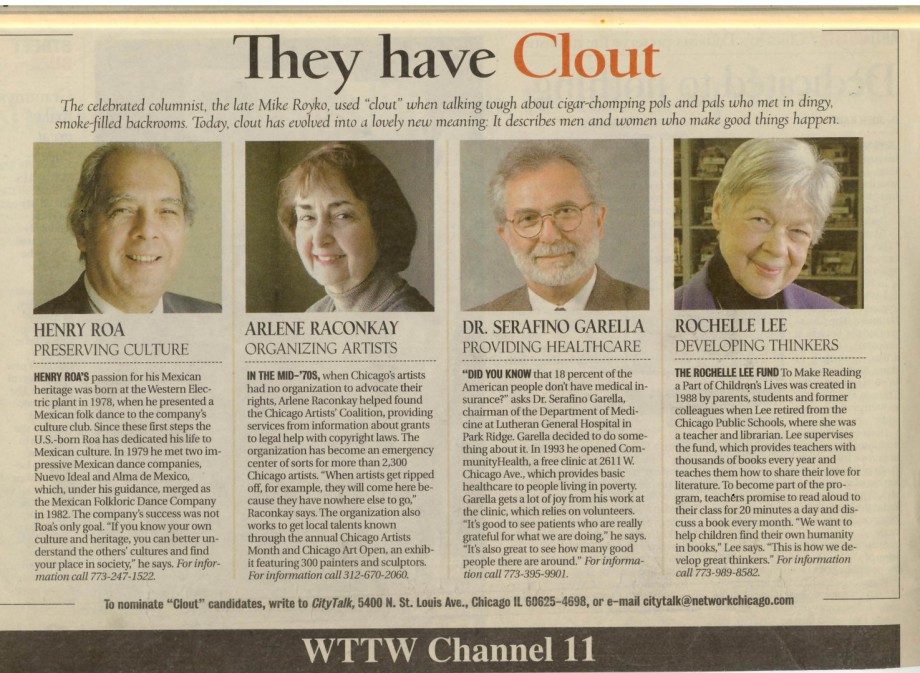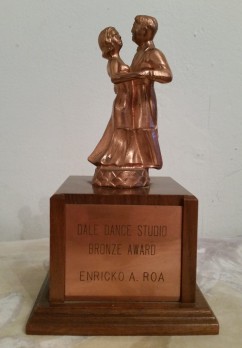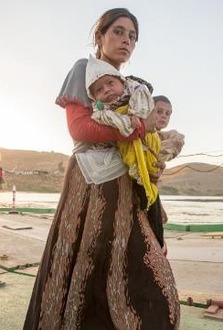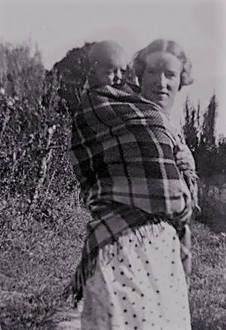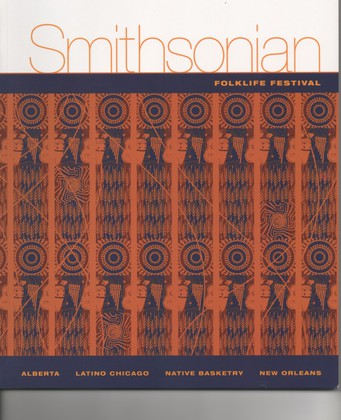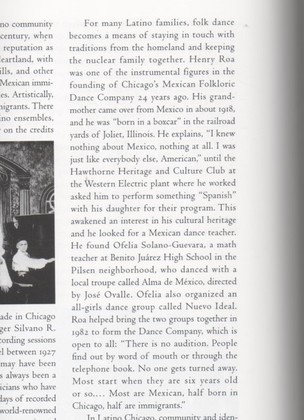ABOUT US
All that I accomplished was done with my wife Juanita; she walked beside me as I walked beside her in her accomplishments.
She passed on May 16, 2015. We miss her.
VIEW HER PROFILE AT BOTTOM.
ABOUT ME:
● Executive Director Mexican Folkloric Dance Company of Chicago www.mexfoldanco.org
● Board member Sones de
Mexico Ensemble www.sonesdemexico.com
● Member Padre Silva Retirement Home Fund in Coatzintla Veracruz, Mexico
● Member American Legion Central Park Post 1028
● President of Our Lady of Fatima Holy Name Society.
RETIRED:
ENGINEERING ASSOCIATE AT&T Technologies formally Western Electric now Alcatel-Lucent Technologies (33 years).
Held Engineering Positions in
● Power ●Standards ●Test Sets ●Repair ●Manufacturing Consultant ●Metals Mill ●Installation ●Capacitors ●Maintenance ●Ordering.
Held Office Positions in: ●Personnel ●Equal Opportunity ●Latino Public Relations.
RETIRED:
Pre-Vocational Career Manager at Methodist Youth Services. Trained Wards of the State in the trades.
MILITARY SERVICE:
Korean Conflict:Sergeant in The Army Signal Corp in Okinawa supervising civilian team replacing obsolete telephone system.
EDUCATION :
● BSBA with minor in Urban Studies: Elmhurst College Elmhurst, IL.
● Business studies at De Paul University, Chicago & University of California at Okinawa.
● Engineering studies Illinois Institute of Technology, Chicago.
● Post Graduate studies University of Illinois, Chicago.
AWARDS; RECOGNITION :
● Cuerdas Clasicas & National Museum of Mexican Art present the Juanita & Henry Roa award; to Guadalupe Piñeda
● Inaugral "Keepers of Culture" award to me and my wife from Sones de Mexico Ensemble. https://youtu.be/lGc0CP67PUY
● Certificate of Recognition as United States Veteran from Cook County Commissioner Jesus Chuy Garcia
● Certificate of Honor for military service in Korea from American Legion Post 1028
● Cook County Veteran certificate and patch by Cook County Commissioner Jesus Chuy Garcia.
● 12 Cardinal Circle Awards for an annual donation, $1,000.00, to Casa Jesus; presented by His Eminence Francis Cardinal George
● 2 awards from Brighton Park Elementary School for LSC service
● Alex Peloso CD Award for service to the community, from Continental Community Center.
● Casa Jesus Award for most years of support presented by His Eminence Francis Cardinal George
● Inaugural Corazon de Jesus Award from Casa Jesus presented by His Eminence Francis Cardinal George
● Fraternal Order of St. Francis Wildcats Man of the Year for community service in the arts.
● Award from Community Education Foundation HS Dist. 214 Arlington Heights
● Museum of Science and Industry Award for volunteer service in Latino Festival events.
● Western Electric Heritage and Culture Club Award as a founding member
● St. Agnes of Brighton Park Holy Name Society Award for years of service
● St. Agnes of Brighton Pk Award as co-founder of Guadalupana Society.
OTHER SERVICE:
● Past Member Pope John Paul II School Board
● Past Admin Assistant Asociacion de Charros Cuatro Caminos
● Past Executive Director Cuerdas Clasicas, Inc. www.cuerdasclasicaschicago.org
● Past Admin Assistant Cuerdas Clasicas, Inc. www.cuerdasclasicaschicago.org
● Past member Brighton Park School LSC
● Past Admin Assistant Federacion de Clubes Unidos Zacatecanos en Illinois
● Past Admin Assistant Hispanic American Alerta Committee of Belvidere
● Past Admin Assistant of Mexican Civic Society of Illinois (Sociedad Civica Mexicana de Illinois)
● Past member of Mexican Civic Society of Illinois (Sociedad Civica Mexicana de Illinois)
● Past Admin Assistant Sociedad Civica Mexico-Americana de Des Plaines
● Past President of Bishop Placido Rodriguez Chicago Scholarships Auxiliary
● Past Bilingual Tutor at Cooper Upper-Grade Center
● Past Entertainment Chairman Museum of Science & Industry Latino Horizons Festival
● Past Panelist for:
● Illinois Arts Council (Arts in Education) (Ethnic & Folk Arts) (Master/Apprentice)
●Chicago Department of Cultural Affairs (Dance)
● Michigan Arts Council (Dance)
PERSONAL:
Married to the late JUANITA RODRIGUEZ for 61 wonderful years; 1 son, Edward,
3 daughters, Laura, Anna and Nicole, 1 grandson, Christopher, 2 granddaughters, Samantha and Olivia, 1 great-grandson, Liam.
ABOUT JUANITA
● Past Secretary/Treasurer of the Mexican Folkloric Dance Company of Chicago.
● Mrs. Roa had a career as a ballroom dancer and singer. She won several awards with the Arthur Murray Dance Studios.
● She was the lead singer in her school concerts and won EVERY singing contest that she participated in for her school.
● She sang in a local Joliet dance band. She could have been a professional singer; a voice like Edye Gorme and Peggy Lee, etc.
● She was active in social, civic, church and school organizations such as
● The Cordi-Marian Woman's Auxiliary.
● Co-founder with Shirley Velasquez and Dolores Reyes of the Bishop Placido Rodriguez C.M.F. Chicago Scholarships Auxiliary.
● Member of Mexican Civic Society of Illinois (Sociedad Civica Mexicana de Illinois)
● Founder of the St. Agnes of Brighton Park Guadalupana Society.
● Founder and principal fund-raiser for the Padre Jose de la Luz Silva Priest Retirement Home in Coatzintla Veracruz, Mexico.
● Casa Jesus House of Formation.
● St. Joseph Seminary.
● Mundelein Seminary.
● St. Agnes church, Brighton Park Chicago multiple societies and clubs.
● Our Lady of Mount Carmel Church, Joliet, IL An original founding family of Felipe and Romana Rodriguez. The
1930s, 40s and 50s.
AWARDS:
● Cuerdas Clasicas & National Museum of Mexican Art present the Juanita & Henry Roa award; to Guadalupe Piñeda
● Inaugural "Keepers of Culture" award from Sones de Mexico Ensemble. https://youtu.be/lGc0CP67PUY
●12 Cardinal Circle Awards for annual donation;
$1,000.00, to Casa Jesus presented by His Eminence Francis Cardinal George
● Inaugural Corazon de Jesus Award from Casa Jesus presented by His Eminence Francis Cardinal George.
● Casa Jesus Award for most years of support presented by His Eminence Francis Cardinal George
● Award from St. Agnes of Brighton Park as the founder of Guadalupana Society.
2017 I posted this on Facebook
My dear wife and I were avid ballroom dancers. She was with Arthur Murray and I was with Dale Dance Studio. We went dancing one, two and three times a week. Some of the places, that I remember were: The Melody Mill, O'Henry Willowbrook, Aragon, Trianon, Mambo City, White City Ballroom, Edgewater Beach Hotel's Beachwalk, Midway Gardens, Rivoli, the Embassy, The Holiday, Boston Club, Boulevard Ballroom, Palladium (?), Paradise Ballroom, Pilsen Park, Savoy Ballroom, Ashland Auditorium and the hall behind it on VanBuren, Dellwood Park Dance Pavilion, Elks Hall, Pioneer Gardens, Vorwaerts Turner Hall, UE Hall, the Blue Angel, Mambo Room, El Mirador and many small neighbourhood clubs that I have forgotten names of except Tito's Hacienda where we proposed marriage to each other (We had been at the Melody Mill until closing time then we went to Tito's) It was a golden age with many wonderful times.
We got this trophy for doing the Tango at Dale Dance Studio. It was buried in a corner of the basement until it was rediscovered. Only my name is on it because I was with the studio. Now I will have her name inscribed on it as it should have been done years ago.
In 1917, my grand uncle, Eduardo Ramirez and my grandmother, Domitila Ramirez carrying her one-year-old daughter, Carmen Valencia (my future mother) crossed the
border to escape the Mexican revolution. Both the Mexican military and the revolutionists treated them badly in Mexico. They paid five centavos to take a shower and were admitted into the USA.
They worked as produce pickers travelling north and eventually settled in Joliet, IL where my granduncle got a better steady job. Fourteen years later, my future mother Carmen, got married; not
unusual, back then, for a woman to marry when 15 years old. I do not remember anything else that my grandmother told us about those years. As kids we just were not interested in such history; we were
“Americans”. My mother too did not take much interest in my grandmother’s stories and I never learned about her father (my grandfather surnamed Valencia) and why he did not come with them. What a
shame.
They were also encouraged by the United States government, which passed a stringent immigration law in 1917 that restricted European and Asian migrants but made an exception for Mexican workers, who were needed to fill jobs on railroads, on farms, and in factories as the country entered World War I. Mills, packinghouses, and railroads sent enganchistas, labor recruiters, to the border to entice workers, generally lone males known as solos, north to cities like Chicago. Many of those labourers did not intend to settle in Chicago permanently; rather, they sought to find seasonal work there or stay until things calmed down back in Mexico (revolution and power struggle afterwards). They faced housing discrimination, being forced to pay higher rents and live in close quarters. Some workers, especially the traqueros, railroad workers, lived in boxcars. Soon colonias, Mexican enclaves, were being established on the Near West Side, in Back of the Yards, and in South Chicago.
The above paragraph is excerpted from a WTTW article by Daniel Hautzinger September 20, 2017
http://interactive.wttw.com/playlist/2017/09/20/chicagos-first-mexican-church#.WejopdRIgpo.facebook
I try to use information that is creditable.
There is much information on the internet that does not have references nor bibliographies.
I found the above pictures on the internet. From them, I can picture my grandmother carrying my mother in her arms or in a sling on her back. They serve me as
a connection to that time of a century ago. I chose the woman with light hair because my grandmother had light hair from her Spanish bloodline.
Also, it reminds me of a time in the 60s when my wife and I were at a Mexican Independence dance and there was a pageant to select a woman who best wore a rebozo. The
prize was about $50.00. One by one the women, dressed in party gowns, strutted down the aisle to the cheers of the crowd. Then the last woman entered dressed as a Mexican peasant woman, without
makeup, in a drab dress. The crowd went silent to the amazement that she carried a baby, in a drab rebozo, in her arms and as she hobbled down the aisle she suddenly flung the baby, over
her shoulder to then carry the baby on her back. The silent crowd burst into the loudest cheering and she won the prize. The crowd realized what the real celebration was about.
The lower left hand corner is enlarged below to show lines 81 to 100.
I will visit the site to view where I was born and try to picture what it was like there, in 1933, when I was born.
UPDATE
I visited the site with my cousin Jesse Roa, who also lived in the boxcars, and Juan Dies who took pictures and a video to present at Sones de Mexico Ensemble's 2017 Gala where my late wife and I were honoured as the inaugural recipients of the "Keepers of Culture" award. https://youtu.be/lGc0CP67PUY
When we got to the site we were encountered by a man, named Gilbert, who asked what we were doing on his property. Juan explained our purpose and the man stated that his mother Connie Gutierrez could help us because she lived in the area since the 1930s. He walked back to his home and a few minutes later Connie drove up and we talked for a while. She provided much evidence of what we were searching for. Then the discussion centred on our relatives of the time and we went to St Cyril Cemetery where some are buried. I visited my father's, my aunt's and my infant brother's graves. It was the first time in about sixty years. Connie then guided us to a woman's home; her name was Henrietta. . . my cousin. I made plans with Connie to include me in any large family gathering so that I can reconnect with my long lost relatives.
We then visited 1115 Hacker Ave. where we lived at around 1938 to 1940. See the 1940 census, below, lines 72 to 77. My maternal grandmother and maternal grand-uncle lived across the street at 1116, see lines 78 and 79. That house is no longer there. We drove up and down the street to be sure that we had the right house. We were encountered by a man, named Guillermo Jaime, that came out of the house and asked what we were doing driving up and down the street. Juan explained and again we were fortunate that the man knew some of the histories of his home. When he named the person that it was purchased from Jesse immediately knew who that person was.
Then we visited the first school that I attended; Lincoln Grammar. and then the second school that I attended; Parks on Parks Ave. From there we drove up the street looking at the homes to see whether our old house, on Parks, where we also lived, was still there. It was not. Then I walked to the end of the street to a railroad track where in the late 1930s and 1940s we picked coal that was strewed along the track. The train engine firemen would throw coal out along the track for our use. It was still depression time for many and the railroad workers helped us keep warm.
In 2006 my profile was featured in the Smithsonian Institue's Folklife Festival book, above. Line nine states that I was born in a boxcar in the railroad yards of Joliet. My mother told us that all of us siblings, (five) were born in that boxcar. I decided to verify it, other than her testimony, and I found the 1930 census, above (Copy and paste to your desktop where you can zoom in to read it better), that shows that indeed there were people living in box cars in the 20s and 30s. Column one shows Woodward Ave. to line 80 and
"E J & E Railroad" from lines 81 to 100.
Lines 86 to 95, 99 and 100 show my relatives. My paternal uncle-in-law Cleto (misspelt as
Gleto) Hernandez is on line 86 his wife my father's I copied this picture from the internet to get an idea of
sister Anita; my aunt, is on line 87. Their children; what our boxcar home might have looked like in the 1930s.
my cousins Alvera and Antonio are on lines 88 and 89. I added my mother's image as I picture her, in my mind,
Line 90 incorrectly shows my uncle Ricardo Roa, my father's .from her words of having lived in the boxcar home.
brother, as a brother-in-law and his wife Dolfina, line 91, However, I wonder whether I might have actually seen
as a sister-in-law (my aunt-in-law). her standing there.
They should have been listed as a separate family with I do have memories of when I was less than 5 years old. Ricardo Roa as head and Dolfina his wife. Line 92 shows
their son Jesse (incorrectly shown as Jesus) as a nephew.
Lines 93 and 94 shows my paternal grandfather and
grandmother, Marcelino Roa and Amrosia.
My father is listed on line 95. My uncle Ramon on line 99
and on line 100 my paternal aunt shown as Jesus which I
think is incorrect ( I will ask my cousin Jesse about it).
Woodward Ave. runs north and south and is less than two
blocks long between Willard Lane and the E J & E Railroad
tracks. The railroad used a dead-end siding to park the box
cars that were used as homes for railroad workers that
needed inexpensive housing..
Below is the 1940 census. It shows Hacker Ave. residents. Just before the census, my parents had moved from the
boxcars to 1115 Hacker Ave. My father is listed on line 72, my mother on line 73, my brother Louis on line 74, I on line 75,
my sister Victoria on line 76 and my brother Michael on line 77. My maternal grand-uncle Eduardo Ramirez is listed on line 78
and my maternal grandmother Domitila Ramirez.(shown incorrectly as Dorothy) is on line 79. We had another brother, Arthur, born in the late 30s who died in infancy before the 1940 census, so there is no record of him in the census.
Those were depression years and when the depression worsened my paternal grandparents, Marcelino and Ambrosia were sent back to Mexico under President Hoover's repatriation Act: When the United States last experienced an economic downturn greater than the present-day depressions, immigrants were often seen as a problem more than a solution because of high unemployment.
As a result, Herbert Hoover authorized the Mexican Repatriation Program, which was the removal – by force if necessary – of both American Citizens of Mexican descent and Mexican immigrants, from American soil. Little is written in history books about this episode in American history. Wikipedia describes the events like this:
The Mexican Repatriation refers to a forced migration that took place between 1929 and 1939 when as many as one million people of Mexican descent were forced or pressured to leave the US. (The term "Repatriation," though commonly used, is inaccurate, since approximately 60% of those driven out were U.S. citizens.) The event, carried out by American authorities, took place without due process. The Immigration and Naturalization Service targeted Mexicans because of "the proximity of the Mexican border, the physical distinctiveness of mestizos, and easily identifiable barrios."
The Repatriation is not widely discussed in American history textbooks; in a 2006 survey of the nine most commonly used American history textbooks in the United
States, four did not mention the Repatriation, and only one devoted more than half a page to the topic. In total, they devoted four pages to the Repatriation, compared with eighteen pages for the
Japanese American internment.
These actions were authorized by Secretary of Labor William Doak and President Hoover publicly
endorsed it. The repatriation targeted areas with large Hispanic populations, mostly in California, Texas, Colorado, Illinois and Michigan.
My
mother,
Carmen circa 1937
So it seems that, after the immigration law of 1917 that welcomed Mexicans, the Repatriation Program of 1929 would send them back. The Repatriation began during Hoover's presidency and he allowed it to proceed. However, Hoover left office in 1933 and Franklin D. Roosevelt became the president. So Roosevelt was president, during the repatriation longer than Hoover; four years by Hoover and six by Roosevelt. Roosevelt did nothing to stop it so is it assumed that he approved it too? In 1942, during world war two, Roosevelt also authorized the deportation and incarceration of both Japanese non-citizens and Japanese citizens with Executive Order 9066.
The immigration dilemma continues today and having unknowingly experienced it eighty years ago I feel a connection with those that are experiencing it today.
I never really knew my paternal grandparents . . . .they never returned .
........ sad
I am grateful that my future father and mother somehow were able to remain, otherwise
would I not be here writing this history?


